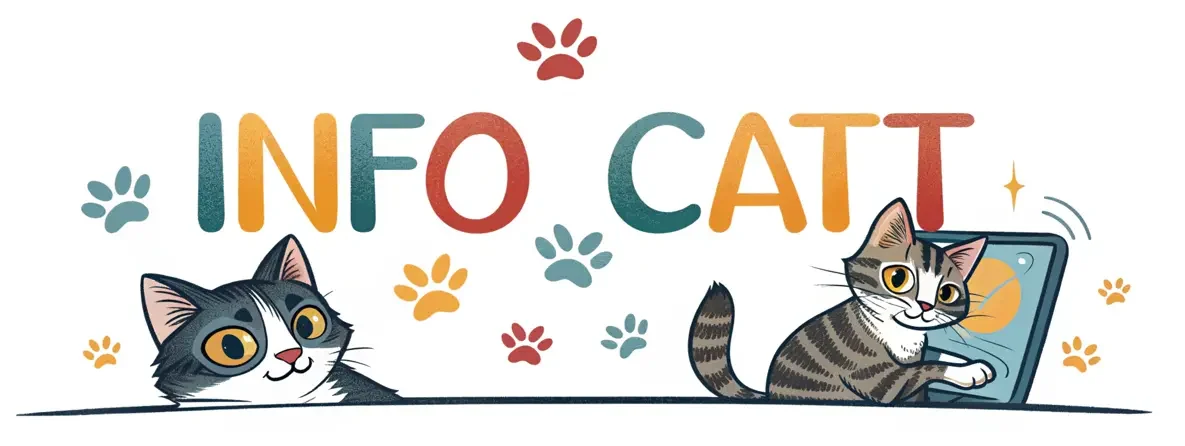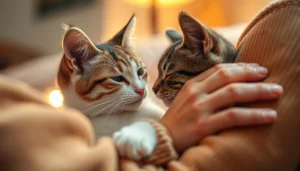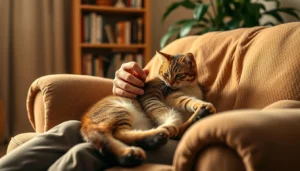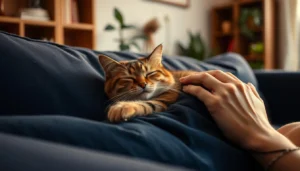Every cat owner dreams of that magical moment when their feline friend willingly snuggles up close. Learning how to make your cat hug you isn’t just about physical contact. It’s about building a deep, trusting relationship that shows how much you care.
Cats show love in their own special ways, unlike humans. They might not hug you like we do, but they have their own signs of affection. Understanding these signs can make your bond with your cat much closer and more loving.
Learning to make your cat hug you takes patience, understanding, and respect for their unique personality. It’s not about forcing them to be close. It’s about creating a safe space where they feel comfortable and want to be near you.
Understanding Cat Body Language and Affection Signals
Cats have their own way of showing feelings. To understand their love, you need to watch their body language closely. Each cat has its own way of showing love and feeling safe.
Cat Social Behavior is full of secret messages. To connect deeply with your cat, learn their special way of showing love.
Decoding Your Cat’s Love Language
Cats show love in many ways that might confuse us. Important signs of cat love include:
- Slow blinking (often called “cat kisses”)
- Kneading with their paws
- Rubbing against your legs
- Presenting their belly
Reading Tail Positions and Ear Movements
Your cat’s tail and ears tell a lot. A happy cat’s tail is slightly curved up. But, if their ears are flat, they might be scared or upset.
- Upright, quivering tail: Extreme excitement
- Tucked tail: Feeling threatened
- Ears forward: Curious and engaged
- Ears sideways: Feeling uncertain
Recognizing Comfort Zones
It’s important to respect your cat’s space to build trust. Not all cats like to be touched right away. Look for signs they’re relaxed and approach them gently when they seem open.
Remember: Every cat is unique and will communicate affection differently.
How to Make Your Cat Hug You: Essential Steps
Learning to make your cat hug you takes patience and understanding. Cats are independent, but you can build a loving bond with them. This bond can include physical affection.
To start your cat cuddle training, create a calm and comfy environment. Cats are more likely to show affection when they feel safe and relaxed. Pick a quiet spot where your cat feels secure and away from distractions.
- Begin with gentle, slow movements
- Use soft speaking tones
- Respect your cat’s personal space
When learning how to hold a cat, follow these important guidelines:
- Support the cat’s entire body
- Keep your grip firm but gentle
- Allow the cat to feel in control
Positive reinforcement is key in encouraging cuddly behavior. Use treats and soft praise to reward your cat for close contact. Short, consistent training sessions help build trust.
Remember: Never force physical interaction. Let your cat set the pace of affection.
Watch your cat’s body language. Signs like a relaxed tail, slow blinks, and purring mean they’re comfortable and might want cuddles. With time and a gentle approach, you’ll have a deeper, more loving bond.
Building Trust Through Daily Interactions
Bonding with your cat takes patience, consistency, and understanding. Cats like things to be predictable and positive. Building a strong bond means more than just occasional attention. It’s about creating a trusting relationship through daily meaningful interactions.
Creating Positive Associations
Starting to show affection to your cat begins with positive experiences. Gentle touches, soft speaking, and calm movements make your cat feel safe and loved. Here are some ways to show your cat love:
- Pet your cat in their preferred spots
- Use a calm, soothing voice
- Respect their personal space
- Avoid sudden movements
Establishing Routine Bonding Sessions
Cats love routine. Set aside specific times each day for interaction, like morning cuddles or evening play. These consistent moments strengthen your bond and make your cat feel secure.
Using Treats and Rewards Effectively
Treats can help build trust. Choose high-quality, cat-specific treats and use them wisely. The goal is to reward good behavior and create fun experiences that strengthen your bond.
- Use small, nutritious treats
- Reward immediately after desired behavior
- Vary treat types to maintain interest
- Never use treats as a primary form of interaction
Remember, every cat is different. Patience and genuine affection are key to a loving relationship.
Common Mistakes to Avoid When Seeking Cat Affection
Understanding cat social behavior can be tricky. Many pet owners make critical errors when trying to show affection to their feline friends. Knowing how to hold a cat and respect their personal space is crucial for building a strong bond.
Cats have unique ways of expressing and receiving love that differ from human interactions. Some common mistakes can actually push your cat away instead of bringing them closer.
- Forcing hugs when cats don’t want physical contact
- Misreading subtle body language signals
- Approaching cats too aggressively
- Ignoring warning signs of stress
Do cats like hugging? Not always. Many cats feel uncomfortable with tight embraces. They prefer gentle interactions that allow them to control the level of physical contact. Respecting their boundaries is key to building trust.
“Cats communicate through subtle cues. Learning to read these signals can transform your relationship.” – Feline Behavior Expert
Instead of forcing hugs, try alternative ways to show affection:
- Slow blinking to demonstrate trust
- Offering gentle pets in their preferred spots
- Allowing them to approach you
- Creating a calm, safe environment
By understanding your cat’s unique social behavior, you’ll create a deeper, more meaningful connection that goes beyond physical contact.
Conclusion
Bonding with your cat needs patience, understanding, and a gentle touch. It’s not about forcing them to show love. Instead, it’s about building trust and comfort.
Every cat is different, with their own likes and boundaries. Showing love and care helps them feel safe and closer to you. The tips shared earlier can guide you in making positive moments together.
Understanding your cat’s needs and how they communicate is key. Watch their body language and respond to their mood. Create safe spaces where they feel valued.
Starting small is the first step to becoming a trusted friend to your cat. Follow the advice in this guide to enjoy those special moments of cuddles and love.
FAQ
Do cats actually like to be hugged?
Most cats don’t like tight hugs like humans do. They prefer gentle, less restrictive affection. This lets them control the situation and escape if needed. Some cats might tolerate hugs from their owners, but many find them stressful.
How can I tell if my cat wants to be close to me?
Look for signs like slow blinks, an upright tail, purring, and kneading. If your cat comes close, rubs against you, or sits near you, they’re showing affection. These are clear signs they’re comfortable with your presence.
What’s the best way to approach my cat for physical affection?
Always let your cat initiate contact. Sit quietly and let them come to you. Use soft, gentle movements and speak calmly. Let them sniff and investigate you. Respect their space and never force interaction if they’re not interested.
Why do some cats dislike being picked up or hugged?
Cats are predators and prey animals. Being restricted triggers their survival instincts. Hugging feels constraining and can make them feel trapped. They prefer interactions where they can control the situation and easily escape if needed.
How can I make my cat more comfortable with physical closeness?
Build trust through consistent, positive interactions. Use treats, gentle petting, and play to create positive associations. Gradually increase physical contact, watching your cat’s body language. Start with brief, light touches and let them set the pace.
At what age is a cat most likely to become affectionate?
Kittens socialized between 2-7 weeks old are more comfortable with human contact. But, cats of all ages can learn to enjoy closeness with patience and gentle approach. Rescue cats or those with negative past experiences might take longer to trust.
Are some cat breeds more cuddly than others?
Yes, breeds like Ragdolls, Maine Coons, Siamese, and Scottish Folds are more affectionate. But, individual personality and early socialization are key. Any cat can become cuddly with the right approach.
What are the signs my cat is feeling stressed during physical interaction?
Watch for flattened ears, tail swishing, dilated pupils, growling, or trying to move away. If your cat seems tense, stop the interaction and give them space. These signs mean they’re feeling uncomfortable and need to be left alone.



